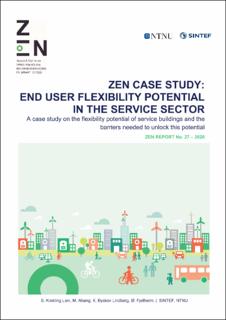| dc.description.abstract | The electricity grid is designed to handle peaks in electricity consumption and is usually dimensioned to handle peak loads at the coldest hours of the year. Over the years to come, investment plans in the Norwegian electricity grids amount to up to 135 billion NOK [1]. A substantial share of the grid investments will be made to avoid bottlenecks that are expected to occur only a few hours each year. Local demand side flexibility, where the user adapts to reduce the electricity consumption in the peak load times, is an economically attractive alternative to grid investments. In the ZEN definition guidelines, it is stated that a ZEN should be able to manage energy flows (within and between buildings) and exchanges with the surrounding energy system in a flexible way.[2]
This report is the result of a ZEN case study by the ZEN-partners SINTEF, NTNU, GK and NVE. The aim of this study was initially to 1) analyse if – and quantify how much service buildings can reduce their peak loads during the Norwegian peak load hour based on actual measured electricity consumption data, and 2) examine what is needed to unlock this, based on case studies on different service buildings with electricity and district heating measurements for different energy purposes. Due to a limited number of detailed measurements of energy use in buildings, the scope of the first part was reduced to a qualitative evaluation of the flexibility potential (rather than quantitative) in the grid's peak load hour, and the number of buildings focused on eight case studies. The flexibility potential of the eight cases was evaluated through analysing the capability of each building to reduce or shift energy consumption during 1) the building's peak load hour and 2) grid's peak load hours in 2019 that occurred on the 31st of January during the hours 07:00-09:00 and 16:00-18:00.
" There is a potential in reducing the building loads during the peak load hours, but there are several barriers linked to unlocking this potential. "
The analysis of the eight buildings studied suggests that there is a potential in reducing the building loads during the peak load hours. In the four buildings with electric heating, the share is at least 28 % at 8 hrs, 16- 20 % at 9 to 10 hrs and at least 17-24 % at 16-20 hrs. The share is somewhat lower at the remaining buildings due to few possible flexibility resources being known in these buildings. The results show a large flexibility potential in the buildings with detailed energy measurements. The findings in the study suggest that there is a potential in reducing the building loads of service buildings during the peak load hours, but there are several barriers linked to unlocking this potential. Currently, the largest barriers are the large investment need to achieve the necessary level of smartness for the building and the lack of off-the-shelf technologies for demand response control. This study has shown that even fever buildings than expected have the necessary smartness level, and large investments is required to release the full flexibility potential. The control system and sales of flexibility must be profitable for the user, where the investments, loss of thermal comfort and inconvenience is sufficiently compensated.
The development of technologies and solutions for the design and operation of energy flexible neighbourhoods and buildings will be further investigated in FME ZEN WP4. | en_US |
